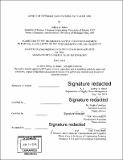Effect of override size on forecast value add
Author(s)
Baker, Jeffrey A. (Jeffrey Arthur)
DownloadFull printable version (4.951Mb)
Other Contributors
Massachusetts Institute of Technology. Supply Chain Management Program.
Advisor
Sergio Caballero and Nima Kazemi.
Terms of use
Metadata
Show full item recordAbstract
Business forecasting frequently combines quantitative time series techniques with qualitative expert opinion overrides to create a final consensus forecast. The objective of these overrides is to reduce forecast error, which enables safety stock reduction, customer service improvement, and manufacturing schedule stability. However, these overrides often fail to improve final forecast accuracy. Process mis-steps include small adjustments, adjustments to accurate statistical forecasts, and adjustments to match financial goals. At best, these overrides waste scare forecasting resources; at worst, they seriously impact business performance. This report offers a framework for identifying overrides that are likely to improve forecast accuracy. A new class of metrics, Dispersion-Scaled Overrides, was developed as an input to the framework. Other inputs included statistical forecast accuracy and auto-correlation. Classification techniques were used to identify whether an override was likely to create forecast value add. These techniques were found to be approximately 80% accurate in predicting success. This result suggests that using Dispersion-Scaled Overrides alongside common forecast accuracy metrics can reliably predict forecast value add. In turn, this can maximize the value that experts add to the business forecasting process.
Description
Thesis: M. Eng. in Supply Chain Management, Massachusetts Institute of Technology, Supply Chain Management Program, 2018. Cataloged from PDF version of thesis. Includes bibliographical references (pages 65-68).
Date issued
2018Department
Massachusetts Institute of Technology. Supply Chain Management ProgramPublisher
Massachusetts Institute of Technology
Keywords
Supply Chain Management Program.